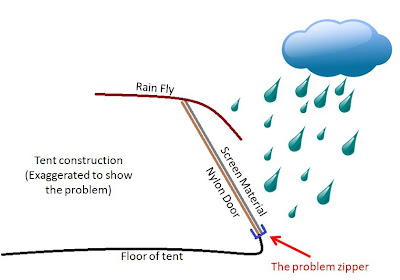My goal was pretty simple, to find a tent large enough I could setup 2 army-style cots and still have room for 2 kids and our gear. Oh- and I wanted two doors and one that was waterproof- the primary reason I didn't like the Coleman tent.
I found the 10x10 Eddie Bauer tent on eBay for $75 plus $35/S/H so I knew I was getting a cheap tent. Although the size was on the small side of what I needed for a family tent, I was drawn to what appeared to be the good rain fly coverage (See this pic)
and screen sides (desirable for camping in Texas).
So I was optimistic and eager to review the tent. Well, it arrived yesterday and there was a chance of rain so I hurried to set it up in advance of the storms because I wanted to see if the rainfly coverage would keep the tent dry like I expected. My results led me to provide some of my own picture of the product:
So why would I be so judgmental about a product I just received and haven't even used for one night? It all amounts to the same problem but I'll try to express it in several ways:
- Poor engineering
- Lack of field testing
- Absence of common sense
- Inattention to detail
- Ultimately, a tent design that GUARANTEES the tent will leak.
At the risk of revealing the obvious prematurely, a picture will help me clearly explain the problem:
So here is what happens, during a rain, even the slightest wind will blow the rain on the portion of the door that is NOT under the rain fly. The rain today wasn't even heavy- somewhere between a drizzle and a sprinkle.
1) Anyway, the rain fell on the screen mesh which provided virtually zero stoppage (it's not supposed to, it's screen!) and stopped at the nylon tent material of the door. 2) At this point, it ran down exterior of the door until it hit the cloth zippers that hold the exterior screen door and the nylon tent door (yes, there are two seperate zippers).
3) Water that drains down, accumulates between the exterior screen door and the interior nylon door- right where the cloth zipper lies.
4) At this point, there is nowhere for the water to go. It just waits until it saturates the cloth zipper material (which doesn't take long) and starts to drip into the interior of the tent.
5) Even if the zipper material were entirely waterproofed, I suspect water would still find its way around the teeth of the zipper.
So my conclusion, with the current design of this tent, it is IMPOSSIBLE for the tent to remain dry in even the slightest of rain. Although I purchased the tent new off eBay, I don't suspect I am going to get any solution from Eddie Bauer or Wenzel although I will certainly try. In the meantime, i want to issue a caution to anyone else who may consider the 10x10 family dome tent from Eddie Bauer/Wenzel.
p.s. - Lest you think my opinion is biased somehow, I found several additional reviews that I WISH I would have discovered before buying this tent.
"I was concerned when I saw large cloth zippers around the windows." ... " This tent leaks like a sieve !!!"http://www.hiking-gear-and-equipment-used-for-camping.com/wenzel-tent.html
"Be aware though that you still might get wet because at least some of the Wenzel
tents are designed in such a way that water will fall off the rainfly and stream
down the tent wall where it may leak through the zipper."
http://www.hiking-gear-and-equipment-used-for-camping.com/eddie-bauer-tent.html
"I've heard of everything from snapped poles, to leaks, to tears, to more leaks
(even after the seams were sealed), to zipper problems, and even zipper leaks."
10/11/2011: UPDATE - So I called their support department and the person I spoke said that the company would not honor the warranty because I purchased the tent off eBay (even though it was claimed to be new). Her only solution was to offer me a discount if I wanted to buy a new Wenzel tent. I cordially but firmly declined explaining that I would not give any more money to Wenzel if I had a choice in the matter.
















